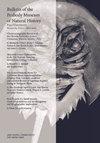基生中生代龟类化石记录综述
IF 0.9
4区 哲学
Q2 BIODIVERSITY CONSERVATION
引用次数: 71
摘要
摘要海龟(Testudinata)是羊膜动物的分支,以完整的龟壳为特征。对该群体系统发育的新见解表明,海龟化石的多样化组合构成了海龟冠(Testudines)的茎系。为了有助于交流,术语Mesochelydia和Perichelydia在本文中被定义为比Testudines更具包容性但比Testudinata更不具包容性的两个内部分支。Testudinata最早的代表是在全球三叠纪晚期(诺里安)至侏罗纪中期的矿床中发现的。伴随着冠Testudines被替代性地分裂为三个主要分支(即Paracryptodira、Pan Pleurodira和Pan Cryptodira),基底周盖虫多样化为三个地理分布重叠的额外分支:欧美的Helochelydrididae、亚洲的Sichuanchelyidae和冈瓦纳大陆南部的Meiolaniformes。沉积学、解剖学和组织学数据普遍暗示了最早的干龟对陆地栖息地的偏好,但在更接近树冠的地方,一个更为复杂但明确的大陆信号是明显的。一项对中生代干龟的分类学综述,不包括冈瓦纳-美奥拉形目的代表,得出结论,在48个命名的分类群中,26个是有效命名群,18个是无效命名群,4个是dubia命名群,1个是无命名群,9个不代表龟。本文章由计算机程序翻译,如有差异,请以英文原文为准。
A Review of the Fossil Record of Basal Mesozoic Turtles
Abstract Turtles (Testudinata) are the clade of amniotes characterized by a complete turtle shell. New insights into the phylogeny of the group have revealed that a diverse assemblage of fossil turtles populate the stem lineage that lead to the turtle crown (Testudines). To aid communication, the terms Mesochelydia and Perichelydia are herein defined for two internested clades more inclusive than Testudines but less inclusive than Testudinata. The earliest representatives of Testudinata are found globally in Late Triassic (Norian) to Middle Jurassic deposits. In concert with the vicariant split of crown Testudines into three primary clades (i.e., Paracryptodira, Pan-Pleurodira, and Pan-Cryptodira), basal perichelydians diversify into three additional clades with overlapping geographic distributions: Helochelydridae in Euramerica, Sichuanchelyidae in Asia, and Meiolaniformes in southern Gondwana. Sedimentological, anatomical, and histological data universally hint at terrestrial habitat preference among the earliest stem turtles, but a more mixed, though unambiguously continental signal is apparent further towards the crown. A taxonomic review of Mesozoic stem turtles, excluding representatives of the Gondwanan Meiolaniformes, concludes that of 48 named taxa, 26 are nomina valida, 18 are nomina invalida, 4 are nomina dubia, 1 is a nomen nudum, and that 9 do not represent turtles.
求助全文
通过发布文献求助,成功后即可免费获取论文全文。
去求助
来源期刊

Bulletin of the Peabody Museum of Natural History
BIODIVERSITY CONSERVATION-ECOLOGY
CiteScore
2.40
自引率
0.00%
发文量
6
审稿时长
>12 weeks
期刊介绍:
The Bulletin of the Peabody Museum of Natural History publishes original research based on specimens, artifacts and related materials maintained in the collections of the Yale Peabody Museum of Natural History’s curatorial divisions. The Bulletin is published twice a year, in April and October.
 求助内容:
求助内容: 应助结果提醒方式:
应助结果提醒方式:


